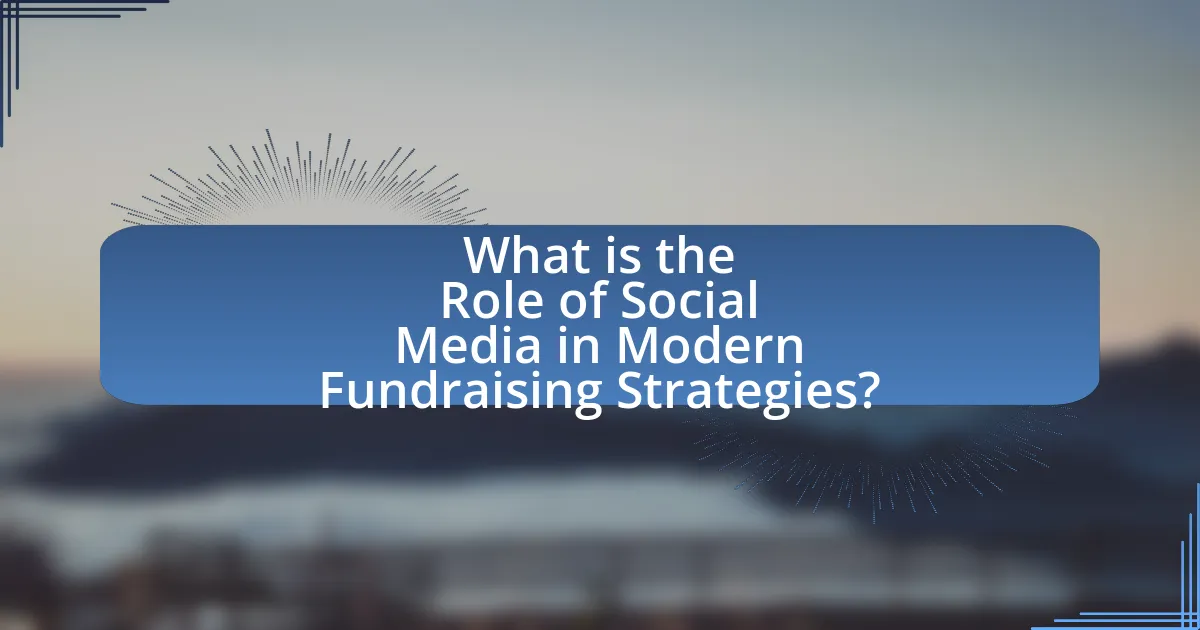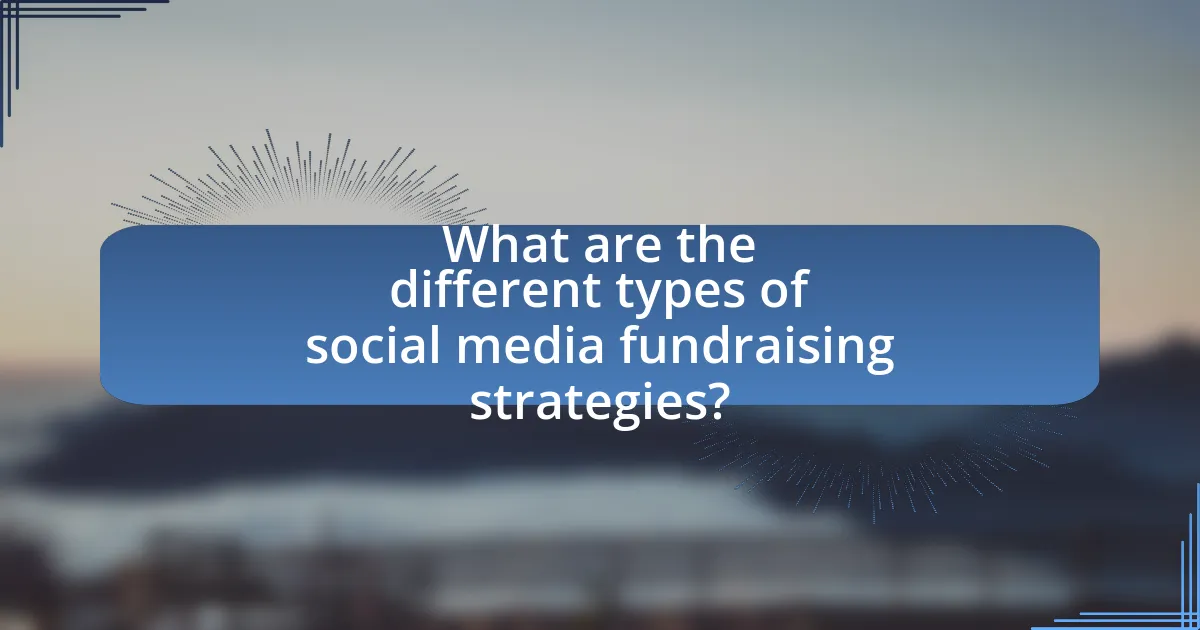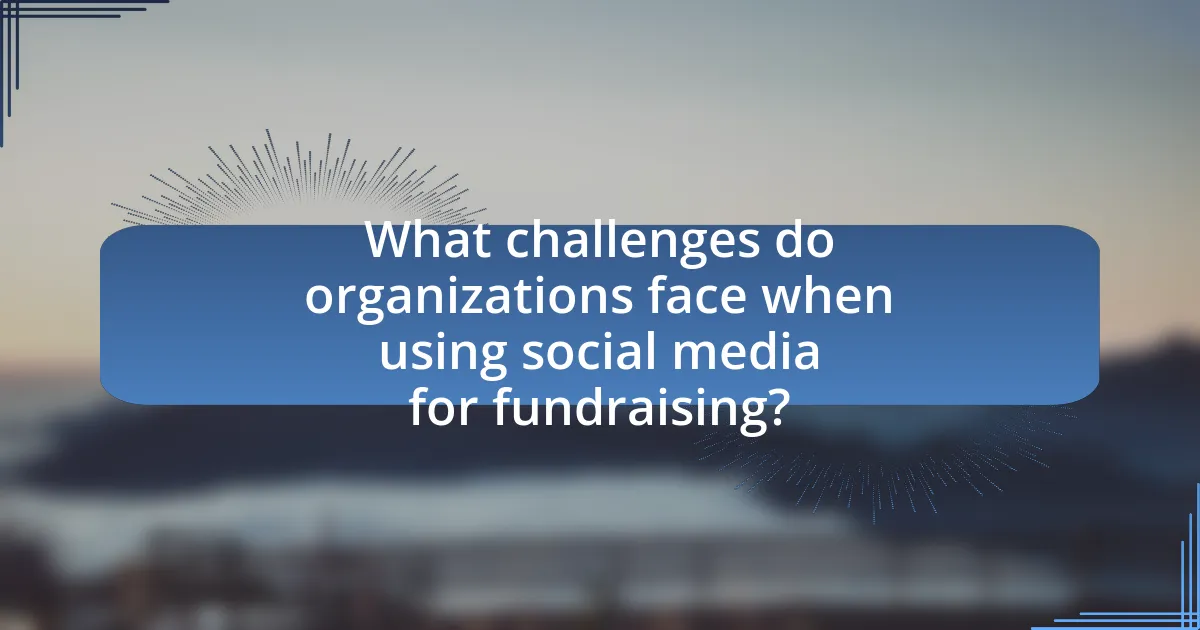The article examines the significant role of social media in modern fundraising strategies, highlighting how platforms like Facebook, Twitter, and Instagram enhance outreach, engagement, and donor interaction. It discusses the transformation of traditional fundraising methods through direct engagement and viral campaigns, such as the ALS Ice Bucket Challenge, which exemplifies the effectiveness of social media in amplifying fundraising efforts. Key differences between traditional and social media fundraising are outlined, along with the advantages of increased visibility, cost-effectiveness, and community building. The article also addresses best practices for leveraging crowdfunding, engaging influencers, and overcoming challenges in social media fundraising, emphasizing the importance of storytelling and data-driven strategies for maximizing donor retention and campaign success.

What is the Role of Social Media in Modern Fundraising Strategies?
Social media plays a crucial role in modern fundraising strategies by enabling organizations to reach a wider audience, engage potential donors, and facilitate real-time communication. Platforms like Facebook, Twitter, and Instagram allow nonprofits to share compelling stories, showcase their impact, and create a sense of community among supporters. According to a 2021 report by the Pew Research Center, 69% of adults in the U.S. use social media, making it an essential tool for organizations to connect with a diverse demographic. Furthermore, social media campaigns can drive traffic to fundraising pages, with studies showing that campaigns utilizing social media can increase donations by up to 30%. This demonstrates that social media is not just a supplementary tool but a fundamental component of effective fundraising strategies today.
How has social media transformed traditional fundraising methods?
Social media has transformed traditional fundraising methods by enabling direct engagement and broader reach to potential donors. Platforms like Facebook, Twitter, and Instagram allow organizations to share their missions, stories, and fundraising campaigns instantly with a global audience. For instance, the ALS Ice Bucket Challenge in 2014 raised over $115 million in just a few months, demonstrating how viral social media campaigns can significantly amplify fundraising efforts compared to traditional methods. Additionally, social media facilitates real-time communication and interaction, allowing organizations to build communities around their causes and encourage peer-to-peer fundraising, which has become a crucial element in modern fundraising strategies.
What are the key differences between traditional and social media fundraising?
Traditional fundraising relies on methods such as direct mail, events, and face-to-face solicitations, while social media fundraising utilizes platforms like Facebook, Twitter, and Instagram to engage donors online. Traditional fundraising often requires significant time and resources to organize events and campaigns, whereas social media fundraising allows for rapid outreach and engagement with a broader audience at a lower cost. For instance, a study by the Pew Research Center indicates that 69% of adults in the U.S. use social media, providing a vast potential donor base that traditional methods may not reach effectively. Additionally, social media fundraising enables real-time interaction and feedback, fostering community and engagement that traditional methods lack.
How do social media platforms enhance donor engagement?
Social media platforms enhance donor engagement by facilitating direct communication and interaction between organizations and potential donors. These platforms allow nonprofits to share impactful stories, updates, and calls to action, which can lead to increased emotional connection and motivation to contribute. For instance, studies show that organizations using social media effectively can see a 20% increase in donor retention rates, as they create a sense of community and belonging among supporters. Additionally, social media enables targeted advertising, allowing organizations to reach specific demographics that are more likely to engage and donate, thus optimizing fundraising efforts.
Why is social media essential for modern fundraising?
Social media is essential for modern fundraising because it enables organizations to reach a vast audience quickly and cost-effectively. With over 4.7 billion active social media users globally, platforms like Facebook, Instagram, and Twitter provide a unique opportunity for nonprofits to engage with potential donors, share their mission, and promote fundraising campaigns. Research by the Pew Research Center indicates that 54% of social media users have engaged with a nonprofit organization through these platforms, demonstrating their effectiveness in mobilizing support and donations.
What advantages does social media offer to fundraising campaigns?
Social media offers significant advantages to fundraising campaigns by enhancing reach, engagement, and cost-effectiveness. Firstly, social media platforms allow campaigns to connect with a vast audience, as over 4.7 billion people use social media globally, providing access to potential donors who may not be reachable through traditional methods. Secondly, social media facilitates real-time engagement, enabling organizations to interact with supporters, share updates, and create a sense of community, which can lead to increased donations. Additionally, social media campaigns are often more cost-effective than traditional fundraising methods, as they require lower financial investment while still generating substantial visibility and support. These advantages collectively contribute to the effectiveness of fundraising efforts in the digital age.
How does social media increase visibility for fundraising efforts?
Social media increases visibility for fundraising efforts by enabling organizations to reach a broader audience quickly and effectively. Platforms like Facebook, Twitter, and Instagram allow for the sharing of fundraising campaigns with a vast network of users, facilitating engagement through likes, shares, and comments. According to a 2021 report by the Pew Research Center, 69% of adults in the U.S. use social media, providing a significant pool for potential donors. Additionally, social media’s algorithmic nature promotes content based on user interactions, further amplifying the reach of fundraising messages. This increased visibility can lead to higher donation rates, as evidenced by a study from the Nonprofit Research Collaborative, which found that organizations utilizing social media for fundraising saw a 30% increase in donations compared to those that did not.

What are the different types of social media fundraising strategies?
Different types of social media fundraising strategies include crowdfunding campaigns, peer-to-peer fundraising, social media challenges, and donation drives. Crowdfunding campaigns leverage platforms like GoFundMe or Kickstarter to gather small contributions from a large number of people, often sharing compelling stories or projects. Peer-to-peer fundraising encourages supporters to create their own fundraising pages, allowing them to solicit donations from their networks, which can significantly expand reach and engagement. Social media challenges, such as the Ice Bucket Challenge, create viral engagement by encouraging participants to share their involvement and challenge others, effectively raising awareness and funds simultaneously. Donation drives utilize social media platforms to promote specific fundraising goals or events, often incorporating live streaming or social media events to engage audiences in real-time. These strategies have proven effective, as studies show that social media can increase fundraising success by up to 30% compared to traditional methods.
How can organizations leverage crowdfunding through social media?
Organizations can leverage crowdfunding through social media by utilizing platforms to reach a wider audience and engage potential backers effectively. Social media allows organizations to share compelling stories, visuals, and updates about their crowdfunding campaigns, which can significantly increase visibility and attract more supporters. For instance, campaigns that include engaging video content on platforms like Facebook or Instagram have been shown to raise 4-5 times more funds than those without. Additionally, organizations can use targeted advertising on social media to reach specific demographics that align with their mission, enhancing the likelihood of contributions. By fostering community interaction through comments and shares, organizations can create a sense of urgency and collective involvement, further driving donations.
What platforms are most effective for crowdfunding campaigns?
The most effective platforms for crowdfunding campaigns include Kickstarter, Indiegogo, GoFundMe, and Patreon. Kickstarter is known for creative projects and has successfully funded over 200,000 campaigns, raising more than $5 billion since its inception. Indiegogo offers flexible funding options and caters to a wide range of projects, while GoFundMe is popular for personal causes and charitable fundraising, having raised over $9 billion. Patreon focuses on ongoing support for creators, allowing them to earn a steady income from subscribers. These platforms have proven effective due to their large user bases, diverse funding options, and strong community engagement.
What are the best practices for running a successful crowdfunding campaign on social media?
To run a successful crowdfunding campaign on social media, it is essential to create engaging content that resonates with your target audience. Engaging content includes high-quality visuals, compelling storytelling, and clear calls to action, which can significantly increase user interaction and sharing. Research indicates that campaigns with videos receive 48% more donations than those without, highlighting the importance of multimedia in capturing attention.
Additionally, leveraging social media platforms’ advertising tools can enhance visibility and reach. For instance, Facebook Ads can target specific demographics, ensuring that the campaign reaches potential backers who are most likely to contribute. A study by the Pew Research Center shows that 69% of adults in the U.S. use Facebook, making it a prime platform for crowdfunding efforts.
Building a community around the campaign is also crucial. Engaging with followers through regular updates, responding to comments, and encouraging user-generated content fosters a sense of ownership and loyalty among supporters. According to a report by the Crowdfunding Center, campaigns that actively engage their audience can see up to 30% higher funding success rates.
Finally, setting a realistic funding goal and timeline is vital. Research from Indiegogo shows that campaigns with clear, achievable goals are 20% more likely to succeed. By following these best practices, crowdfunding campaigns can effectively utilize social media to maximize their chances of success.
What role do social media influencers play in fundraising?
Social media influencers play a crucial role in fundraising by leveraging their large followings to promote charitable causes and campaigns. They create awareness and drive engagement through authentic storytelling and personal connections with their audience, which can significantly increase donations. For instance, a study by the Pew Research Center found that 70% of teens trust influencers more than traditional celebrities, making influencers effective in reaching younger demographics who are increasingly involved in social causes. Additionally, campaigns that utilize influencers often see higher engagement rates; for example, a report from the Digital Marketing Institute indicated that influencer marketing can yield an ROI of up to 11 times the initial investment, demonstrating the financial impact influencers can have on fundraising efforts.
How can partnerships with influencers enhance fundraising efforts?
Partnerships with influencers can enhance fundraising efforts by leveraging their established audiences to increase visibility and engagement for fundraising campaigns. Influencers possess the ability to reach large, targeted demographics, which can lead to higher donation rates. For instance, a study by the Nonprofit Marketing Guide found that organizations that utilized influencer partnerships saw a 30% increase in donations compared to those that did not. Additionally, influencers can create authentic content that resonates with their followers, fostering trust and encouraging them to support the cause. This combination of reach and authenticity significantly boosts the effectiveness of fundraising initiatives.
What strategies can organizations use to engage influencers effectively?
Organizations can engage influencers effectively by establishing authentic relationships, providing value, and leveraging data-driven insights. Building genuine connections involves personalized outreach and understanding the influencer’s audience and interests, which fosters trust and collaboration. Offering value can include exclusive content, early access to products, or co-creating campaigns that resonate with both the influencer’s followers and the organization’s mission. Utilizing data-driven insights allows organizations to identify the right influencers based on engagement metrics and audience demographics, ensuring alignment with their goals. Research indicates that campaigns with authentic influencer partnerships can yield up to 11 times higher ROI compared to traditional advertising methods, demonstrating the effectiveness of these strategies.

What challenges do organizations face when using social media for fundraising?
Organizations face several challenges when using social media for fundraising, including audience engagement, platform algorithm changes, and competition for attention. Engaging potential donors effectively requires creating compelling content that resonates with diverse audiences, which can be difficult to achieve consistently. Additionally, social media platforms frequently update their algorithms, impacting the visibility of fundraising posts and making it harder for organizations to reach their target audience. Furthermore, the crowded social media landscape means that organizations must compete with numerous other causes and messages, which can dilute their fundraising efforts. These challenges highlight the complexities organizations encounter in leveraging social media as a fundraising tool.
How can organizations overcome the challenges of social media fundraising?
Organizations can overcome the challenges of social media fundraising by implementing targeted strategies that enhance engagement and trust. For instance, they can utilize data analytics to identify and reach specific demographics, ensuring that their messaging resonates with potential donors. Additionally, organizations should create compelling content that tells a story, as studies show that emotional narratives can increase donor engagement by up to 300%. Furthermore, establishing transparent communication about how funds will be used builds trust, which is crucial; research indicates that 70% of donors are more likely to contribute when they feel informed about the impact of their donations. By leveraging these strategies, organizations can effectively navigate the complexities of social media fundraising.
What are common pitfalls to avoid in social media fundraising?
Common pitfalls to avoid in social media fundraising include lack of clear goals, insufficient audience engagement, and neglecting to track performance metrics. Establishing clear goals is essential, as campaigns without defined objectives often fail to resonate with potential donors. Engaging the audience through interactive content and timely responses fosters a sense of community and encourages contributions. Additionally, neglecting to analyze performance metrics can lead to missed opportunities for improvement; for instance, a study by the Nonprofit Research Collaborative found that organizations that track their fundraising efforts are more likely to meet their financial targets.
How can organizations measure the success of their social media fundraising efforts?
Organizations can measure the success of their social media fundraising efforts by analyzing key performance indicators (KPIs) such as total funds raised, engagement rates, and conversion rates. Total funds raised provides a direct measure of financial success, while engagement rates, which include likes, shares, and comments, indicate how well the campaign resonates with the audience. Conversion rates, calculated by dividing the number of donations by the total number of visitors to the fundraising page, reveal the effectiveness of the social media strategy in driving donations. According to a report by the Nonprofit Marketing Guide, organizations that track these metrics can improve their fundraising strategies by 30% or more, demonstrating the importance of data-driven decision-making in social media fundraising.
What are the best practices for maximizing social media fundraising?
To maximize social media fundraising, organizations should focus on creating engaging content, leveraging storytelling, and utilizing targeted advertising. Engaging content, such as videos and images, captures attention and encourages sharing, which can increase reach and donations. Storytelling connects emotionally with potential donors, making them more likely to contribute; studies show that campaigns with compelling narratives can raise up to 300% more than those without. Targeted advertising allows organizations to reach specific demographics, enhancing the effectiveness of fundraising efforts; for instance, Facebook’s advertising platform enables precise targeting based on interests and behaviors, leading to higher conversion rates.
How can storytelling enhance fundraising campaigns on social media?
Storytelling can enhance fundraising campaigns on social media by creating emotional connections that motivate potential donors to contribute. Engaging narratives about beneficiaries or the impact of donations can evoke empathy, making the cause more relatable and compelling. Research indicates that campaigns incorporating storytelling can increase engagement rates by up to 300%, as emotional content is more likely to be shared and remembered. This heightened engagement translates into increased visibility and, ultimately, higher donation rates, demonstrating the effectiveness of storytelling in driving fundraising success on social media platforms.
What tips can organizations implement to improve donor retention through social media?
Organizations can improve donor retention through social media by actively engaging with donors, sharing impactful stories, and providing regular updates on the organization’s activities. Engaging with donors through personalized responses and interactive content fosters a sense of community and belonging, which is crucial for retention. Sharing stories that highlight the impact of donations can emotionally connect donors to the cause, reinforcing their commitment. Regular updates on projects and financial transparency build trust and keep donors informed, which is essential for long-term relationships. According to a study by the Nonprofit Research Collaborative, organizations that maintain consistent communication with donors see a 20% higher retention rate compared to those that do not.


